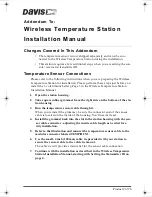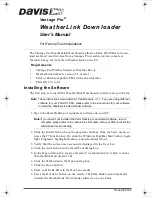
44
Initial operation:
• Insert 2- AA batteries into the rain sensor
according to polarity:
1. Press the funnel’s buckle (C1 position),
pick up the funnel and you will see the
internal rain sensor.
2. Press the sensor’s buckle (C4 position),
pick up the rain sensor, and you will see
the battery compartment below the rain
sensor.
3. Insert 2 AA batteries correctly according
to the battery polarity of the battery
compartment.
4. The sensor back into the base, and let the
buckle lock position.
• Open the battery cover of the main
device (B6 position), and correctly load
2 AA batteries according to the battery
polarity in the battery compartment.
• When you insert the batteries, all the icon
on the LCD display will brie� y light up for
3 seconds, and you will hear a beep tone,
and detect indoor temperature.
• The main unit will now start to connect
to the outdoor remote sensor. This
operation will be completed in 3 minutes.
When receiving the radio signal from the
outdoor sensor, the radio signal icon will
be displayed and � ashing.
• In about 3 minutes, the main device will
automatically receive the signal from
the outdoor sensor. The rain value and
the outdoor temperature value will be
displayed on the LCD display, and the
radio icon will not � ash.
• After the master successfully receives
the signal from the remote sensor, it will
immediately exit the remote wireless
receiving mode.
Wireless sensor mounting position
1. Before installing the � xed sensor,
remove the cardboard around the rain
bucket and the tape around the rocker.
These are sensors used to protect
against accidental movement during
transportation.
2. Mount your remote sensor in an open
area for a more accurate rain count.
3. Placing the remote sensor on the ground
provides the most accurate rainfall
measurement as there is no wind shear.
Unfortunately, since insects think of
remote sensors as personal hotels,
placing your sensor 1-2 meters (3-6 feet)
above ground may deter the insects.
4. This is a self-emptying sensor, but be sure
your unit is not sitting in a depression
that would prevent rain from draining
out of the bottom
5. Your remote sensor should be accessible
to allow for periodic cleaning of leaves or
other debris that may clog the funnel.
6. Install the remote sensor on a level
platform that is stationary and has a
direct line of sight to your station.
7. Insert mounting screws through the
holes in the base of the rain sensor. Do
not over tighten.
8. Use the bubble level (C3 position) inside
your sensor to be sure it is level.
9. After securing the base of the sensor,
place the funnel section over the sensor
and make sure the buckle is locked to the
base.
10. Avoid other wireless rain sensors as
this can cause inaccuracy due to signal
interference.
















































